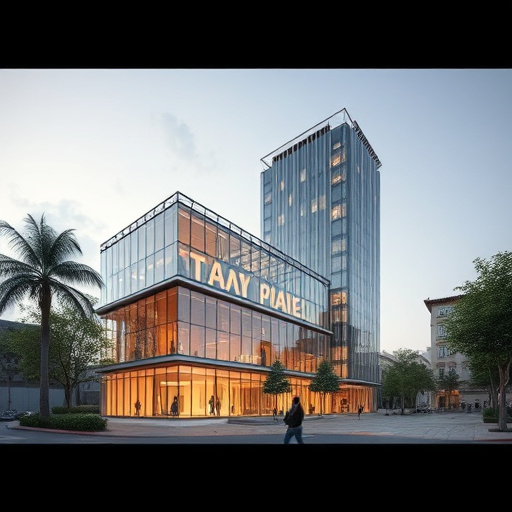Category: commercial upgrade
Commercial Upgrade: Transforming Business Horizons
Introduction
Welcome to an in-depth exploration of a concept that is reshaping the global business landscape—the Commercial Upgrade. This comprehensive guide aims to unravel the intricacies of this term, offering valuable insights into its impact on economies, technologies, and societies worldwide. By the end of this article, readers will grasp the far-reaching implications of commercial upgrades and their role in driving progress, innovation, and sustainability.
Understanding Commercial Upgrade: A Definition and Its Components
Definition:
Commercial upgrade refers to the process of modernizing and enhancing commercial activities, systems, and infrastructure to improve efficiency, productivity, and competitiveness. It involves strategic investments in technology, business models, and operational processes to meet evolving market demands and global standards.
Core Components:
- Technology Integration: Adopting advanced technologies such as artificial intelligence, blockchain, Internet of Things (IoT), and cloud computing to streamline operations and gain a competitive edge.
- Business Model Innovation: Developing new revenue streams, diversifying offerings, and implementing dynamic pricing strategies to adapt to changing consumer preferences.
- Operational Efficiency: Optimizing processes, automating tasks, and leveraging data analytics to enhance productivity, reduce costs, and improve overall operational effectiveness.
- Infrastructure Development: Upgrading physical and digital infrastructure, including transportation networks, communication systems, and data centers, to support growing commercial needs.
Historical Context:
The concept of commercial upgrade has evolved over centuries, driven by technological revolutions and economic shifts. From the Industrial Revolution’s mechanization to the digital age’s automation, each era has witnessed significant upgrades in how businesses operate. Today, the pace of change is accelerated, with advancements in technology and globalization demanding continuous adaptation and evolution.
Global Impact and Trends: A World Transformed
International Influence:
Commercial upgrade is a global phenomenon, impacting countries across all continents. The International Monetary Fund (IMF) estimates that digital technologies alone could contribute $12 trillion to the global economy by 2030, underscoring the immense potential of commercial upgrades.
Regional Trends:
- North America and Europe: These regions lead in digital transformation, with advanced e-commerce ecosystems and tech-driven business models. The EU’s Digital Single Market initiative aims to create a seamless digital environment, fostering cross-border trade.
- Asia Pacific: Rapid urbanization and a young, tech-savvy population drive commercial upgrades in this region. China, for instance, has become a global hub for e-commerce and fintech innovation.
- Emerging Markets: Countries like India and Brazil are embracing digital transformation to bridge the development gap. Mobile penetration and digital literacy are rising, enabling new business opportunities.
Impact on Local Economies:
Commercial upgrades often stimulate economic growth, create jobs, and improve living standards. They encourage entrepreneurship, foster innovation, and attract foreign investment. For example, the rise of tech startups in Silicon Valley has contributed to California’s thriving economy and influenced global technological trends.
Economic Considerations: Markets, Investments, and Systems
Market Dynamics:
- Disruption and Disparities: Commercial upgrades can disrupt traditional markets, leading to both positive and negative outcomes. While they create new opportunities, they may also widen wealth gaps if not managed equitably.
- Global Value Chains: Upgrades often reshape global supply chains, allowing for more efficient production and distribution. Countries specializing in specific sectors can gain competitive advantages.
- Price Sensitivity: Changing consumer behaviors and technology costs influence pricing strategies. Dynamic pricing models, leveraging real-time data, enable businesses to adapt swiftly.
Investment Patterns:
- Venture Capital and Private Equity: These sectors play a crucial role in funding commercial upgrade initiatives, especially in tech startups and innovative business models.
- State-Driven Investments: Governments worldwide are investing in infrastructure, research, and development to support digital transformation and maintain economic competitiveness.
- Risk and Return: Upgrading businesses often involves risks but offers substantial returns if successful. Diversified investment strategies and risk management are essential.
Economic Systems and Upgrade Strategies:
- Market Liberalization: Removing trade barriers and promoting free markets encourages competition, innovation, and efficiency, fostering commercial upgrades.
- Regulatory Frameworks: Governments must strike a balance between regulation to protect consumers and markets and enabling business flexibility for growth.
- Public-Private Partnerships: Collaborative efforts can optimize resources and expertise, accelerating infrastructure development and technological adoption.
Technological Advancements: Driving the Upgrade
Key Technologies:
- Artificial Intelligence (AI): AI empowers automated decision-making, enhances customer experiences, and optimizes operations across industries. For instance, recommendation systems in e-commerce improve sales while personalizing user experiences.
- Blockchain: This technology ensures secure, transparent, and tamper-proof transactions, revolutionizing supply chain management, financial services, and digital identities.
- Internet of Things (IoT): IoT connects physical devices, enabling data exchange and remote control, with applications in smart cities, healthcare, and agriculture.
- Cloud Computing: Cloud services offer scalability, flexibility, and cost savings for businesses, allowing them to store and access data remotely.
Impact on Industries:
- Retail and E-commerce: AI-driven personalized marketing, augmented reality shopping experiences, and same-day delivery are transforming how consumers interact with retailers.
- Healthcare: Telemedicine platforms, wearable health devices, and blockchain-based patient records enhance accessibility and efficiency in healthcare delivery.
- Manufacturing: IoT sensors monitor equipment health, enabling predictive maintenance and improving production efficiency. AI optimizes supply chains and reduces waste.
Future Potential:
Emerging technologies like quantum computing, 5G networks, and extended reality (XR) hold immense potential for commercial upgrade. These innovations can revolutionize industries further, creating new business models and customer experiences.
Policy and Regulation: Navigating the Legal Landscape
Key Policies and Regulations:
- Data Protection Laws: Such as the General Data Protection Regulation (GDPR) in Europe, ensure consumer privacy and data security, impacting how businesses handle customer information.
- Competition Policy: Antitrust and competition laws promote fair market practices, prevent monopolies, and encourage innovation.
- Cybersecurity Regulations: With increasing cyber threats, governments worldwide are implementing regulations to enhance online security.
Influence on Commercial Upgrade:
- Compliance Costs: Businesses must invest in compliance measures, which can impact profitability, especially for smaller enterprises.
- Innovation vs. Regulation: Balancing innovation and regulation is crucial. Overregulation may hinder progress, while inadequate policies can leave businesses vulnerable to cyber risks.
- Global Harmonization: International cooperation on data privacy and cybersecurity regulations is essential to facilitate global digital trade.
Challenges and Criticisms: Overcoming Obstacles
Common Challenges:
- Initial Investment Costs: Upgrading infrastructure, adopting new technologies, and reskilling employees require substantial upfront investments, which can be a barrier for small businesses.
- Digital Divide: Despite global connectivity advances, the digital divide persists, with unequal access to technology and internet services, especially in rural areas.
- Regulatory Uncertainty: Rapid technological changes often outpace regulatory frameworks, leading to legal uncertainties and compliance challenges.
Criticisms and Solutions:
- Inequality and Job Displacement: Critics argue that automation may lead to job losses, exacerbating income inequality. However, history shows that technology also creates new jobs; reskilling programs and education reforms can mitigate these risks.
- Data Privacy Concerns: With vast data collection, privacy becomes a major issue. Transparent data practices, user consent, and stringent regulations are necessary to address these concerns.
- Cybersecurity Threats: As systems become more interconnected, cyberattacks pose significant risks. Collaboration between governments, industry, and cybersecurity experts is vital for robust defense mechanisms.
Case Studies: Real-World Success Stories
Case Study 1: Smart City Transformation – Singapore
Singapore’s “Smart Nation” initiative showcases a comprehensive commercial upgrade. The government partnered with private sectors to develop digital solutions for transportation, healthcare, and public services. IoT sensors monitor traffic flow, optimizing city infrastructure. This transformation has improved efficiency, enhanced citizen experiences, and positioned Singapore as a global tech hub.
Case Study 2: Digital Agriculture Revolution – Netherlands
Dutch farmers have embraced technology, using AI and IoT to optimize crop yields and resource use. Drones survey fields, while smart irrigation systems ensure efficient water usage. Blockchain-based supply chain tracking enhances transparency and consumer trust. These innovations have made Dutch agriculture sustainable and globally competitive.
Case Study 3: Fintech Disruption – Kenya
M-Pesa, a mobile money transfer service in Kenya, revolutionized financial services, especially in rural areas with limited banking access. This case highlights how mobile technologies can provide financial inclusion and economic empowerment to underserved communities.
Future Prospects: Emerging Trends and Strategic Considerations
Potential Growth Areas:
- Green Technologies: As sustainability becomes a global focus, commercial upgrades in renewable energy, electric vehicles, and circular economy practices will gain momentum.
- Healthcare Tech: Telemedicine, AI diagnostics, and personalized medicine will continue to transform healthcare delivery, improving accessibility and patient outcomes.
- Extended Reality (XR): VR and AR technologies will revolutionize education, entertainment, and remote collaboration, creating immersive experiences.
Emerging Trends:
- Edge Computing: Processing data closer to the source reduces latency, enabling real-time decision-making for IoT applications in industries like autonomous vehicles and smart cities.
- Quantum Computing: This technology promises exponential processing power, revolutionizing complex problem-solving, cryptography, and simulation.
- Web3 and Decentralization: The shift towards decentralized web technologies, blockchain, and cryptocurrencies may reshape digital interactions and business models.
Strategic Considerations for Businesses:
- Agile Mindset: Businesses must embrace agility and adaptability to stay relevant in a rapidly changing landscape. Continuous learning and innovation are essential.
- Digital-First Strategy: Investing in digital infrastructure and skills is crucial for future growth, ensuring businesses can meet evolving customer demands.
- Partnerships and Collaborations: Public-private partnerships and industry collaborations enable the sharing of resources, expertise, and risks, accelerating innovation.
Conclusion: Navigating the Future Together
The concept of commercial upgrade is a dynamic force shaping our world, driving progress, and defining the future of business. From technological advancements to global economic trends, its impact is profound and far-reaching. This article has provided a comprehensive overview, highlighting the potential, challenges, and strategic considerations surrounding this topic.
As we move forward, commercial upgrades will continue to transform industries, enhance productivity, and improve lives. By embracing technology, fostering innovation, and addressing regulatory and social challenges, businesses can navigate these transformative times successfully. The future holds immense possibilities, and those who adapt and upgrade will be at the forefront of this exciting journey.
FAQ Section: Answering Common Queries
Q: How does commercial upgrade impact small businesses?
A: Commercial upgrade presents both opportunities and challenges for small businesses. While adopting new technologies can enhance efficiency, initial investment costs might be a hurdle. However, government incentives, accessible financing options, and leveraging cloud-based solutions can help them participate in the digital transformation.
Q: What role does government play in commercial upgrades?
A: Governments play a crucial role by creating enabling environments through policy frameworks, infrastructure investments, and education reforms. They can foster innovation, attract investment, and ensure fair competition, ultimately driving economic growth and development.
Q: How can businesses prepare for emerging technologies like quantum computing?
A: Businesses should stay informed about emerging technologies, invest in research and development, and collaborate with academic institutions and tech experts. Staying agile and flexible will enable them to adapt quickly and leverage new opportunities.
Q: What are the key considerations for ethical commercial upgrade practices?
A: Ethical considerations include data privacy, algorithmic transparency, and ensuring technology benefits all segments of society. Businesses should adopt responsible AI practices, prioritize consumer consent, and promote digital literacy to create a fair and inclusive digital future.
Commercial Upgrades: Ensuring Compliance with Industry Regulations

Staying ahead in heavily regulated industries requires understanding and adhering to evolving regula…….
Commercial Upgrade: Enhance Appeal, Attract More Tenants

A strategic commercial upgrade involves balancing practical improvements like lighting and internet…….
Mastering Commercial Upgrade: Layout Strategies for Success
Modular Systems: Revolutionize Commercial Upgrades, Save Time, Money

Modular systems transform commercial upgrade projects with their flexibility and customization optio…….
Mastering ADA Compliance for Successful Commercial Upgrades

Prioritizing accessibility and safety in commercial upgrades is crucial. Essential modifications inc…….
Streamline Workflow with Effective Commercial Upgrade Integration

Evaluating workflow and identifying bottlenecks is crucial for a successful commercial upgrade. Focu…….
Mastering Commercial Upgrades: Longevity Through Material Choice

Commercial upgrades require a strategic material selection process, balancing aesthetics with functi…….
Elevate Your Brand With Strategic Commercial Upgrade Integration

Before upgrading, assess brand positioning through target audience analysis, market trends, and comp…….
Seamless Commercial Upgrade: Plan, Execute, Communicate Effortlessly

Before upgrading a commercial space, conduct a thorough assessment and set clear goals. Evaluate lay…….









